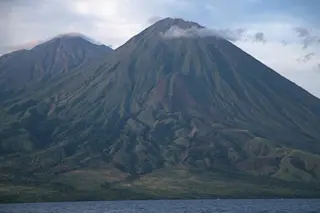Sangeang Api in Indonesia seen in October 2000. Image: Jack Z / Wikimedia Commons. Indonesia is a very busy place, volcanically speaking. Sometimes, the rumblings at different volcanoes change so quickly that you can lose track of which ones are showing new signs of activity and which have been restless for years. In the past few months, we've seen a few volcanoes come back into "restless" column, so I thought I'd try to catch us up on them.
Sangeang Api
Sangeang Api (which I've also seen written as one word - Sangeangapi; above) is in the Lesser Sunda Islands and hasn't erupted since 1999. (At least it is the last confirmed eruption.) Currently, the volcano sits on orange/3 alert, meaning that there are signs of increased unrest -- however, finding additional information about activity there has been problematic. Checking out the map overlay on Volcano Discovery, you can see that a small swarm of earthquakes has been occurring under the island and some reports from the same time suggest small, wispy steam plumes from the summit. The volcano is on an island by itself as this 2002 NASA Earth Observatory image shows, but over 1,000 people live on the small island as these images from the VEI 3 1985 eruption of the volcano attests - it prompted evacuations after lava flows, lahars and ash flows were generated.
Raung
Located on Java, Raung is exactly what you would expect a volcano to look like if you had to draw one. Steep sides, big caldera at the top and massive. It sits on the periphery of the already rumbling Ijen caldera as well, so this part of Java is packed with volcanoes. Raung is also quite active - between 2000 and 2008, the volcano had at least six periods of heightened eruptive activity (all in the ~VEI 2 range), but since 2008, it has been quiet. However, that appears to have changed as starting in late October, seismicity spiked at Raung (but is now subsiding some) and small, less-than-100-meter ash explosions occurred at the volcano. Now, an eruption of Raung could be quite disruptive (as many eruptions in densely populated Indonesia can be) as there is a lot of coffee grown on the slopes of Raung -- coffee loves its volcanic soils -- so there would likely need to be significant evacuations depending on the size of the eruption. Currently, Indonesia officials have a 3-km exclusion zone from the main crater of the volcano.
Rokatenda
Over in the Flores Islands, Rokatenda (also known as Paluweh) is also on orange/3 alert status. Of the three volcanoes in the spotlight today, it has had the longest period of quiescence, having not had a confirmed eruption since 1985. During the course of 2012, Rokatenda has been seeing seismicity wax and wane, but by mid-October, the unrest had reached the level where the alert status was upgraded. A report today out of Indonesia mentions minor ash fall on villages surrounding the volcano. The image accompanying the report shows some steaming areas in the main crater, but it appears to have been taken in May 2012. The 1928 VEI 3 eruption of Rokatenda produced a tsunami when part of the volcano collapsed into the surrounding seas and ended up causing almost 100 fatalities.














